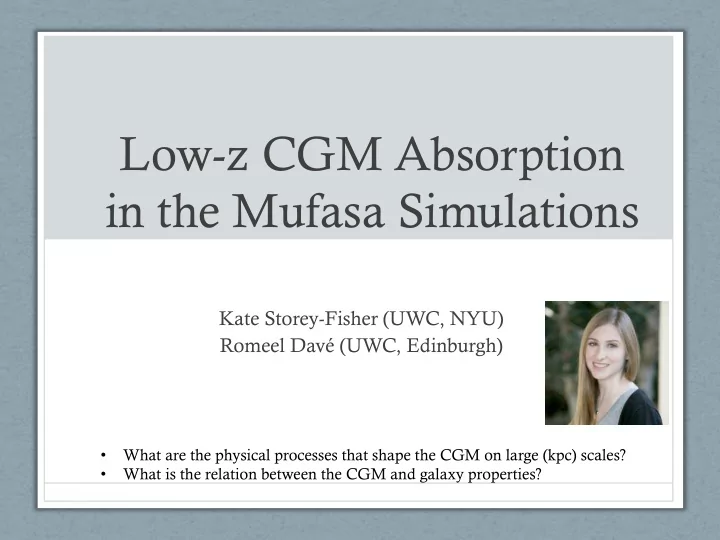

Low-z CGM Absorption in the Mufasa Simulations Kate Storey-Fisher (UWC, NYU) Romeel Davé (UWC, Edinburgh) • What are the physical processes that shape the CGM on large (kpc) scales? • What is the relation between the CGM and galaxy properties?
GIZMO-MUFASA GIZMO: Gadget gravity+“meshless” hydro (Hopkins) • Grackle cooling+heating, including metals, non-equil primordial • Star formation (H 2 -based), minimal ISM pressure • 9-metal chemical enrichment: Type II/Ia + AGB stars & heat • Kinetic decoupled winds (+ SN heating) based on FIRE scalings • Quenching via prevention of halo gas cooling in M halo >10 12+0.48z M � • Projected neutral hydrogen 25 Mpc/h Hopkins+15 z=2 z=1 z=0
Mufasa’s new features vs. our previous sims in Ford+13,14,16 Mufasa Oppenheimer+Davé • Gizmo: MFM • Gadget-2: Old (EC) SPH • FIRE-based wind scalings • Mom + E-driven scalings • Thermal M halo -based quenching • Kinetic M * -based quenching • 30% SN-heated outflows • Cold (~10 4 K) outflows • 50% SNII yields (better MZR) • Full yields (too high MZR) • Very good MF & red sequence • Good MF, no RS Davé+16,17,17b Davé+11a,11b
COS-Halos+COS-Dwarfs ~300 HST orbits total Detect: HI, OVI, CII, CIII, {CIV}, SiII, SiIII, SiIV , MgII (from Keck), … Shout out to X for pyigm!
COS-Halos matched sample 5 central galaxies per COS-Halo/Dwarf galaxy, 4 orientations (+/-x,y) Red/blue selected at sSFR=0.01 Gyr -1
Spectral generation pygad : SPH-based analysis suite (B. Roettgers, MPA); • Absorption spectra + a whole lot more! Fast, flexible, public (bitbucket.org/broett/pygad) • Self-shielding (Rahmati+13 α J ν ), damping wings. • Bernhard Roettgers Outputs τ -weighted T, ρ , Z for each ion. • Very good match to specexbin (our previous code). • Sum to get EW , column within +/- 600 km/s • [no Voigt profile fitting – but see our Bayesian MCMC VP • fitter VAMP: github.com/christopherlovell/VAMP (in prep)]
Mass Fraction in CGM Phases
Metal fraction in CGM Phases WHIM (not hot) dominates for quenched galaxies Cool CGM dominates for SF galaxies
EW vs. impact parameter OVI too low!
CIV in COS-Dwarfs Mean is about right, scatter too small
EW Distribution
Covering fractions
Integrated Column per ∆ z (±600 km/s) dEW/dz dEW/dz Ford+16
Physical conditions vs. IE ion
Summary • Mufasa matches COS-Halos about as well our previous sims. • HI matches reasonably well, even for massive red galaxies. • Low ions (SiIV ,CIII) are low by x2-3 around blue galaxies, almost nonexistent around red galaxies. • Mid ion (CIV) from COS-Dwarfs is okay, but spread is small. • OVI low by x2-3 in integrated column (dN OVI /dz) or EW . Weaker around red galaxies, as observed. • OVI shows strong ρ , Τ dependence on mass; other ions don’t. • Some discrepancies may be helped by metal-loaded outflows. • Origin of low ions around passive galaxies remains a puzzle!
Recommend
More recommend